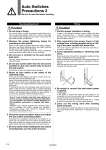
m-03-3c-seihin_en 19 / 77
10秒後にBOOKのページに移動します
1.Do not drop or bump. Do not drop, bump, or apply an excessive impact (300 m/s2 or more for reed auto switches, 1000 m/s2 or more for solid state auto switches) while handing the auto switch. It may cause the auto switch to break or malfunction. 2. Observe the proper tightening torque for mounting an auto switch. When an auto switch is tightened beyond the range of tightening torque, auto switch mounting screws, auto switch mounting brackets or auto switch may be damaged. On the other hand, tightening below the range of tightening torque may allow the auto switch to slip out of position. 3. Do not carry a cylinder by the auto switch lead wires. This may cause disconnection of the lead wire or the internal element to break. 4. Do not use screws other than the set screws installed on the auto switch body to secure the auto switch. If using other screws, auto switch may be damaged. 5. Mount an auto switch at the center of the operating range. In the case of 2-color display auto switch, mount it at the center of the green LED illuminating range. Adjust the mounting position of the auto switch so that the piston stops at the center of the operating range. (The mounting position shown in the catalog indicates the optimum position at stroke end.) If mounted at the end of the operating range (around the borderline of ON and OFF), operation will be unstable depending on the operating environment. Also there are some cylinders or actuators with individual setting methods for auto switches. If so, mount it in accordance with the indicated method. 6. Check the actual actuation status and adjust the auto switch mounting position. According to the installation environment, the cylinder or actuator may not operate even at its proper mounting position. Even when setting at a midpoint of the stroke, check the actuation status and make the adjustment in the same manner. 7. Be very careful when handling the auto switch mounting band, as it has a thin structure. 1. Confirm proper insulation of wiring. If there is any improper insulation (mixed contact with other circuit, grounding fault, or improper insulation between terminals, etc.) in the wiring, an over-current flows in, causing the auto switch to break. 2. Wire separately from power lines or high voltage lines, avoiding parallel wiring or wiring in the same conduit with these lines. If an inrush current is generated, the noise may cause the auto switch to malfunction. 3. Avoid repeatedly bending or stretching lead wires. Broken lead wires will result from repeatedly applying bending stress or stretching force to the lead wires. Stress and tensile force applied to the connection between the lead wire and auto switch increases the possibility of disconnection. Keep the lead wire from moving especially in the area where it connects with the auto switch. 4. Be certain to connect the load before power is applied. <2-wire type> If the power is turned ON when an auto switch is not connected to a load, the auto switch will be instantly damaged because of excess current (short circuit). It is the same as when the 2-wire brown lead wire (+, output) is directly connected to the (+) power supply terminal. 5. Carry out the wiring work after shutting down the power. If the wiring work is performed with the power turned ON, this may cause electric shock, malfunction, or damage to the auto switch. Wiring Caution Caution Auto Switches Precautions 2 Be sure to read this before handling. Mounting/Adjustment Even if 2-color indication solid state auto switches are fixed at a proper operating range (the green light lights up), the operation may become unstable depending on the installation environment or magnetic field disturbance. (Magnetic body, external magnetic field, proximal installation of cylinders with built-in magnet and actuators, temperature change, other factors for magnetic force fluctuation during operation, etc.) A 14